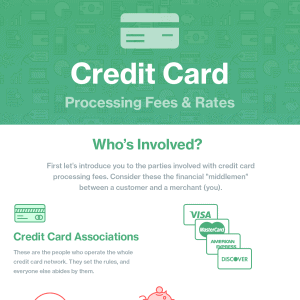The big four credit card brands are everywhere, but which one fits your small business?
Our content reflects the editorial opinions of our experts. While our site makes money through
referral partnerships, we only partner with companies that meet our standards for quality, as outlined in our independent
rating and scoring system.
We usually think about rewards, APRs, or perks when choosing a credit card. But how often do you consider the network behind it?
There’s more to networks like Visa, Mastercard, American Express, and Discover than just their names. Each one has its own rules, fees, and ways of processing transactions — and those differences can impact your business’s costs.
In this guide, we’ll break down what card networks actually do, how their fee structures work, and how they affect your business’s credit card selections and processing choices.
What Is A Credit Card Company?
A credit card company, also called a credit card network, can refer to a card brand and/or a card issuer.
The most common brands are Visa, Mastercard, American Express, and Discover.
Credit Card Brand VS Credit Card Issuer
| Card Network |
Lends Money? |
Owns Network? |
Typical Role |
Notes |
| Visa |
No |
Yes |
Sets rules, fees, and network standards |
Works with banks to issue cards; doesn’t lend |
| Mastercard |
No |
Yes |
Sets rules, fees, and network standards |
Works with banks to issue cards; doesn’t lend |
| American Express |
Yes |
Yes |
Issues cards, lends money, and processes transactions |
Acts as both issuer and network |
| Discover |
Yes |
Yes |
Issues cards, lends money, and processes transactions |
Acts as both issuer and network |
Are card brands the same as card issuers? Sometimes (but usually not).
A credit card issuer is typically a bank that provides you with a credit card, essentially giving you a revolving line of credit to pay for your purchases. They handle the lending, billing, and interest.
A card brand (like Visa or Mastercard) doesn’t lend money. Instead, it sets rules and fees (such as interchange rates) that banks, processors, and merchants must follow. If you break the rules, the brand can restrict your ability to process those cards.
American Express and Discover work differently. Each operates both as a card brand and issuing bank, using its own network to issue cards and process transactions.
How Do Credit Card Companies Work?
Think of credit card networks like a franchise system:
- Visa and Mastercard: Franchisors
- Issuing banks: Franchisees
- Cardholders: Customers
American Express and Discover are like franchisor-owned stores: they handle both the network and the issuing bank functions directly.
Franchisors (card networks) set rules for the franchisees (issuing banks) and enforce them, just like Visa and Mastercard set guidelines for banks.
They also handle marketing, which is why you recognize the brand more than the issuing bank. You know you have a Mastercard, but the bank that issued it often seems invisible.
This franchise analogy isn’t perfect because it doesn’t capture everything networks do. But it gives a useful framework for understanding the system. This matters because the network’s rules and fees directly affect how you accept payments and how much it costs.
Are Credit Card Networks The Same As Debit Networks?
Debit transactions can run on two types of networks:
- PIN debit: Routed through a separate network with immediate fund transfer. Usually carries lower interchange fees than credit-based debit.
- Credit-based debit: Routed through the credit card network, but funds are pulled from the account immediately.
Some card networks also own debit networks (for example, Discover runs the PULSE network). So under certain circumstances, a credit card network can also process debit transactions.
To simplify things further, here’s a quick comparison of how credit and debit transactions move through networks:
| Transaction Type |
Network Used |
Funds Transfer Timing |
Notes |
| PIN Debit |
Debit-specific network (e.g., PULSE) |
Immediate |
Uses a separate processing network from credit cards |
| Credit-Based Debit |
Credit card network (Visa, Mastercard, etc.) |
Immediate |
Money is pulled from the account right away, but processes like a credit card |
| Credit Card |
Credit card network |
End of billing cycle (unless paid immediately) |
Standard credit card transaction; interest applies if balance carried |
Why Credit Card Companies Matter For Payment Processing
Not all credit card companies handle processing fees the same way. Understanding how transactions flow helps explain the differences between Visa, Mastercard, American Express, and Discover.
Key players in a card transaction:
- Cardholder: The consumer making the purchase
- Issuing bank: The bank that gave the card to the consumer
- Acquiring bank: The bank that processes payments for the merchant
- Card network/association: Visa, Mastercard, Amex, or Discover
- Processor: The company that handles the technical side of the payment
- Merchant: The business accepting the payment
With that in mind, here’s how a payment works:
- The card info is encrypted and sent from the merchant to the processor.
- The processor identifies the acquiring bank and sends the transaction along.
- The acquiring bank forwards it to the appropriate card network (Visa, Mastercard, Amex, Discover).
- The card network matches the transaction to the correct issuing bank and runs fraud or verification checks. (Amex and Discover skip this as they are their own issuing banks.)
- The issuing bank verifies credit availability and approves or declines the purchase.
- Authorization travels back through the network to the merchant.
- If approved, funds move from the issuing bank to the acquiring bank, then to the processor, and finally to the merchant.
- The issuing bank bills the cardholder for repayment later.
Bottom line: Card networks play a crucial role in moving transactions along — and they charge fees for it.
The Role Of Credit Card Companies
Credit card brands play a huge role in payment processing beyond just slapping a logo on a card. Here’s what they actually do.
Set Card Brand Rules
Every card brand has a thick rulebook that merchants must follow. Violating these rules can get your account terminated or even put you on the MATCH list.
Rules differ by brand; Visa, Mastercard, and Discover all have unique requirements. Following them keeps you legally safe and compliant with payment processing standards.
Determine Data Security Standards
Card associations helped create the PCI Security Standards Council, which sets end-to-end rules for storing and transmitting payment data.
These standards cover encryption, hardware security, and employee access controls. They do not cover active fraud detection, which is handled separately by processors and the card networks themselves.
Set Interchange Rates
Interchange rates — the base cost of processing cards — are set by the card associations, not your processor. This ensures banks and other participants are compensated fairly while keeping the system consistent.
Build & Maintain Payment Networks
Networks like VisaNet (since 1973) and Mastercard’s systems handle authorization, clearing, and settlement. The card brands operate the central “nerve center,” routing information between merchants, processors, and issuing banks in milliseconds.
Prevent & Detect Cybercrimes
Beyond PCI rules, card associations use advanced technology to monitor transactions, detect fraud, and prevent breaches.
Tokenization (replacing card numbers with secure tokens) is an example of collaboration between Visa, Mastercard, and American Express (Discover uses its own system). These tokenization standards are still evolving as the networks coordinate through EMVCo.
Marketing & Brand Awareness
Card associations advertise heavily to build consumer recognition. This is why consumers often know the brand more than the issuing bank. For instance, Mastercard rebranded from Interbank to Master Charge to create a unified, recognizable global brand.
How Credit Card Networks Affect Your Small Business
Even if you don’t deal directly with Visa, Mastercard, American Express, or Discover, their decisions have a real impact on your business.
These networks influence:
- Processing fees: What you pay to accept card payments.
- Rules and compliance: What standards and practices you must follow.
- Customer reach: How many cardholders can shop with you.
- Card structure: How cards are issued and used by consumers.
Knowing these differences can help you choose which cards to accept and manage costs effectively.
Accepting Different Card Brands Through Your Merchant Account
Years ago, merchants often accepted only one or two card brands. Some restaurants took only American Express for lower interchange rates, and Discover struggled with adoption.
Today, most processors allow merchants to accept all four major brands. However, some organizations (like certain government agencies) still accept only Visa or Mastercard for ease of convenience fees. Before signing a processing contract, confirm with your processor which cards you can accept.
To choose the right solution, check out the best payment processors for your business. Or, if you are in the market for getting a credit card for business use, check out our list of the best business credit cards to find the right card for any situation.











